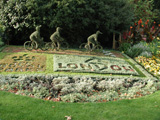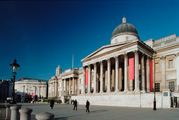A VICTORIAN OBSESSION
Originally published in January 2015 in American In Britain Winter 2014-2-15
This is a unique opportunity to see fifty-two remarkable paintings on loan from the private collection of Juan Antonio Pérez Simón, a wealthy Mexican art collector with the largest Victorian art collection outside Great Britain. Daniel Robbins, Senior curator at Leighton House, has described the exhibition as an opportunity to show paintings which have seldom if ever been exhibited before. They are by the most celebrated Victorian artists, many of whom were Leighton’s friends and contemporaries. Six paintings by Leighton are on display, four of them back ‘home’ to the house in which they were painted. A Victorian Obsession: The Pérez Simón collection at Leighton House Museum. 14 November 2014 – 29 March 2015. Open every day except Tuesday, 10.00am …
A VICTORIAN OBSESSION
By Abby Cronin
As you step into the inner hall of Leighton House Museum to visit the current exhibition, A Victorian Obsession, pause at the foot of the tiled stairway. Look up and your attention will focus on an exquisite painting of Queen Esther hung on the upper wall. Edwin Longsden Long, RA, painted Queen Esther’s beauty and finery in a muted palette with assiduous attention to detail; it portrays a biblical story in a Babylonian setting. Long’s remarkable painting (1878) helps to establish the context for the exhibit; it sets the scene and highlights key themes, namely, historical views of Orientalism, classical antiquity and most notably, feminine beauty.
Long’s Queen Esther is just one of fifty-two remarkable paintings on loan from the private collection of Juan Antonio Pérez Simón, a wealthy Mexican art collector with the largest Victorian art collection outside Great Britain. Daniel Robbins, Senior curator at Leighton House, has described the exhibition as an opportunity to show paintings which have seldom if ever been exhibited before. They are by the most celebrated Victorian artists, many of whom were Leighton’s friends and contemporaries. Six paintings by Leighton are on display, four of them back ‘home’ to the house in which they were painted.
Frederic, Lord Leighton (1830-1896) built his opulent Holland Park residence in the 1860s. Noted for its exceptionally stunning Arab Hall with its gold mosaic frieze and oriental tiles, the house combines the intimacy of a private home and palace of art; it is perfectly suited to display the Pérez Simón Collection. Except for Leighton’s studio, the permanent collection of paintings in Leighton House has been cleared to make space for Pérez Simón’s pictures. The rich interiors provide the atmosphere of an art salon; paintings are hung in perfect settings. Extensive care has been taken to place them so they complement the different rooms. The public are invited to view these masterpieces as they stroll through the domestic and public areas. There are works by some less well-known artists such as John Melhuish Strudwick and Simeon Solomon as well as notablepre-Raphaelite painters John Everett Millais, Dante Gabriel Rossetti and Edward Burne-Jones. Exceptional works by immensely popular painters of the period include Lawrence Alma-Tadema, Albert Moore, Edward Poynter and, of course, by Frederic Leighton himself. Visitors can wander through the authentic period interiors and view High Victorian art as it would have looked at the time it was created.
If there is a star in this exhibit it must be Lawrence Alma-Tadema’s magnificent work, The Roses of Heliogabalus, 1888. It is displayed upstairs in The Upper Perrin Gallery which is devoted to telling the story behind The Roses together with a preparatory oil sketch, supporting drawings and photographs. Lawrence Alma-Tadema had a love of ancient Rome and always strived for historical accuracy. At first glance the women appear to be relaxing seductively. But in reality they were smothered – swamped in rose petals. In The Roses, his most ambitious picture, Alma-Tadema is “responding to the contemporary fascination with decadence in the ancient world, [he] represents the depraved young emperor Heliogabalus (203-222AD) suffocating his guests beneath a torrent of rose petals.” (1) Here Alma-Tadema portrays horror, the opposition between the apparent beauty of the scene and the actual cruelty being enacted. The co-curator Véronique Gerard-Powell explains that John Aird, one of the leading engineers of the Victorian age, paid £6,000 prior to the appearance of The Roses in the Royal Academy’s annual exhibition in May 1888. Acquired by Juan Antonio Pérez Simón in 1993, the painting has not been seen in London since 1913.
Albert Moore (1841-1893) was influenced by the Pre-Raphaelite movement, yet his work A Painter’s Quartet: A Tribute to the Art of Music, 1868, has elements drawn from Japanese prints and the idealisation of beauty based on Greco-Roman sculpture. Quartet illustrates a close connection between art and music. Three women, partially clothed in classically-styled drapery, focus their attention on a string quartet of four male musicians. It is a highly stylised composition with deliberate anachronisms, historical inaccuracies and includes contemporary instruments which look out of place in this setting. Moore was obviously less concerned about portraying historically accurate subject matter than developing purely Aesthetic decorative paintings. In this composition he aimed to portray an ideal of female beauty fused with music.
The ‘Victorian Obsession’ with female beauty knew no bounds. So it is hardly surprising that the exhibition includes some exceptionally fine paintings of scantily clad and naked women. Whilst the representation of female beauty is a key feature in the Pérez Simón collection, it is worth noting that not one of the paintings in the exhibition is by a woman artist. Although female British models have pride of place in several works on display, nude modelling was viewed very differently in this period. It was respectable to be painted ‘from the head’, but many artists painted partially covered or completely naked women. Remarkably stunning paintings in this genre include Daniel Gabriel Rossetti’s Venus Verticordia, Frederick Goodall’s The Finding of Moses, Edward John Poynter’s Andromeda, Albert Moore’s A Bathing Place, and John William Godward’s Study for At the Tepidarium. All of these paintings are in the exhibition. They depict feminine beauty in many different ways: women are presented as central figures in historical events, biblical stories, British myths, legends and the art and poetry of classical antiquity.
The question arises: who were the models for these artists? Art historians’ research has found a lot of evidence to answer this question. In the case of Frederic Leighton, Dorothy Dene (born Ada Alice Pullan born in 1859) was well known as his model and muse. Their relationship is really a Pygmalion story. As the daughter of an impoverished father from south London, Ada Alice Pullan found herself and her siblings with few options. A natural beauty, she began modelling for Louisa Starr and other artists at the studios in Holland Park. She soon came into Leighton’s life and became his principal model until his death. Leighton was sensitive to the financial situation of Ada’s family and encouraged other artists to have her model for them. Despite his respected public profile amongst the upper echelons of the art world, Leighton led a solitary private life and remained unmarried. There has been endless speculation about the nature of his relationship with Dorothy Dene. She had ambitions to become an actress and Leighton supported her by paying for acting and elocution lessons. Her stage success was limited but she and Leighton remained close and were seen together at social events. Dorothy was at his bedside when he died. He left her money in his will and his sisters set up the ‘Dene Trust’ to support Dorothy’s sisters.
Among Leighton’s many paintings and sketches of Dene, perhaps Crenaia, the Nymph of the Dargle, 1880, is one of the most beautiful. The picture reveals Dorothy as a sensual nymph and the subtlety of her nudity is viewed beneath folds of drapery which blend into the waterfall behind. She is tall and slender unlike Ingre’s La Source (1856), said to have influenced Leighton when he saw it in Ingre’s studio in Paris. Co-curator Véronique` Gerard-Powell describes Crenaia: “Her elongated proportions contrast with those of Ingres’ petit French model …[and] are emphasised by the long fluid, transparent folds of her drapery…..the nymph chastely clasps her hands across her breast, modestly lowering her face and eyes.”(2)Leighton’s style of painting has been described as a struggle to establish a path between the classical tradition and the Aesthetic movement. Crenaia appears to have resolved this struggle.
This exhibition is a unique opportunity to become acquainted with 52 treasured Victorian paintings loaned by Mexican collector Juan Antonio Pérez Simón. It is fitting to see them returned to studio interiors of the period, Leighton House Museum. Their presence here in London provides us with an opportunity to re-assess the grandeur of High Victorian art, often scorned as unfashionable. It is hoped that this exhibit will open our eyes so that we may appreciate the many superb works of late 19th-century British art, many of which, sadly, have left home. __________________________________________________________________________________________
NOTES
- Visitors are given a guide to the paintings on loan displayed in each room
- Visitor’s Guide includes a comprehensive Events Programme
- Book to see the play about Dorothy Dene: Dates in the guide: Performances on March 13,14,20, 23, 24, 25 ,27 & 28 2015
- There is an audio guide to provide more information about the paintings & the Pérez Simón Collection
- Catalogue A Victorian Obsession: The Pérez Simón Collection at Leighton House published in 2014 by the Royal Borough of Kensington and Chelsea 12 Holland Park Road, London W14 8LZ
A Victorian Obsession: The Pérez Simón collection at Leighton House Museum. 14 November 2014 – 29 March 2015. Open every day except Tuesday, 10.00am
museums@rbkc.gov.uk www.rbkc.gov.uk
Catalogue references: P 55 2. P.113
Get in touch. Contact: Abby Cronin artsjournalist@abbycronin.co.uk Website: www.abbycronin.co.uk




